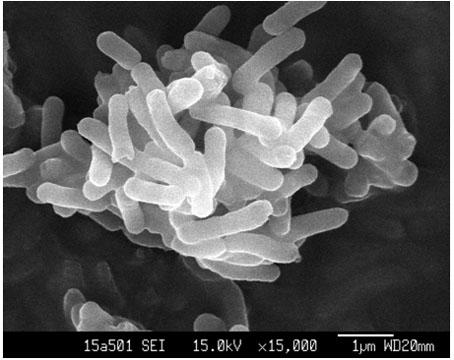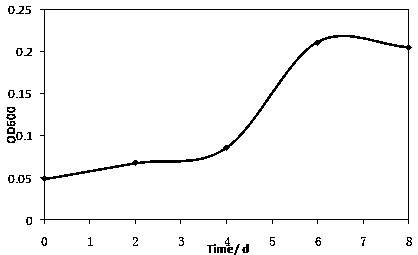A kind of Citrobacter y3 with the function of degrading brominated flame retardants and its application
A Citrobacter, functional technology, applied in the direction of bacteria, microbial-based methods, biological water/sewage treatment, etc.
- Summary
- Abstract
- Description
- Claims
- Application Information
AI Technical Summary
Problems solved by technology
Method used
Image
Examples
Embodiment 1
[0036] Example 1 Isolation and Identification of Citrobacter Y3
[0037] 1. Enrichment and isolation of strains
[0038] Continuous-flow anaerobic reaction with hexabromocyclododecane as a contaminant grown for 2 years from the laboratory
[0039] Take out 5ml of the mud-water mixture from the instrument and culture it in a standard serum bottle, and at the same time add an inorganic salt culture solution containing 5mg / L hexabromocyclododecane (see Table 1 for the composition of the culture solution), anaerobic at 30°C, and a shaker with a rotation speed of 120rap After one week of enrichment and acclimatization in medium, transfer the inorganic salt medium containing 8mg / L hexabromocyclododecane with 10% inoculation amount and then acclimatize for a week, and gradually increase the concentration of hexabromocyclododecane for acclimatization by analogy, hexabromocyclododecane The use concentrations of cyclododecane were 10, 15, and 20 mg / L, respectively. After acclimatizati...
Embodiment 2
[0091] Example 2 Degradation test of Citrobacter Y3 to hexabromocyclododecane under anaerobic co-metabolism conditions
[0092] 1. For the isolated and purified Citrobacter Y3 under anaerobic conditions and the serum bottle experiment for the degradation of HBCD without adding co-metabolism substrates, samples were taken every 2 days until the eighth day to detect hexabromocyclododecane The degradation rate of cyclododecane and the growth of strain OD 600nm .
[0093] 2. After experiments, the inventors found that under the condition of using hexabromocyclododecane as a single carbon source, the growth of the bacteria was very slow within eight days, and the degradation efficiency of hexabromocyclododecane was only about 40%. This shows that HBCD is a refractory persistent organic compound, and the strain may lack the corresponding enzyme in the body, so it is difficult to use HBCD as an energy source to support its growth. Therefore, the method of adding co-metabolism subst...
Embodiment 3
[0096] Example 3 Effects of Different Concentrations of Co-Metabolite Substrates on the Degradation of Hexabromocyclododecane by Citrobacter Y3
[0097]The inventors also explored the effects of different concentrations and different types of co-metabolite substrates on the degradation of hexabromocyclododecane by strain Y3, respectively setting up gradient experiments with different concentrations of glucose, maltose, sucrose, starch and sodium citrate, and comparing their effects on the hexabromocyclododecane. The impact of bromocyclododecane degradation efficiency, determine the optimum range or optimum ratio under optimum degradation conditions.
[0098] Firstly, five different concentrations (10, 100, 500, 1000, 2000mg / L) were set according to the different ratios of the co-metabolism substrate and the pollutant HBCD to explore the optimum between the co-metabolism substrate and the pollutant substrate. relation. As we all know, the ratio of growth substrate and non-grow...
PUM
 Login to View More
Login to View More Abstract
Description
Claims
Application Information
 Login to View More
Login to View More - R&D
- Intellectual Property
- Life Sciences
- Materials
- Tech Scout
- Unparalleled Data Quality
- Higher Quality Content
- 60% Fewer Hallucinations
Browse by: Latest US Patents, China's latest patents, Technical Efficacy Thesaurus, Application Domain, Technology Topic, Popular Technical Reports.
© 2025 PatSnap. All rights reserved.Legal|Privacy policy|Modern Slavery Act Transparency Statement|Sitemap|About US| Contact US: help@patsnap.com



